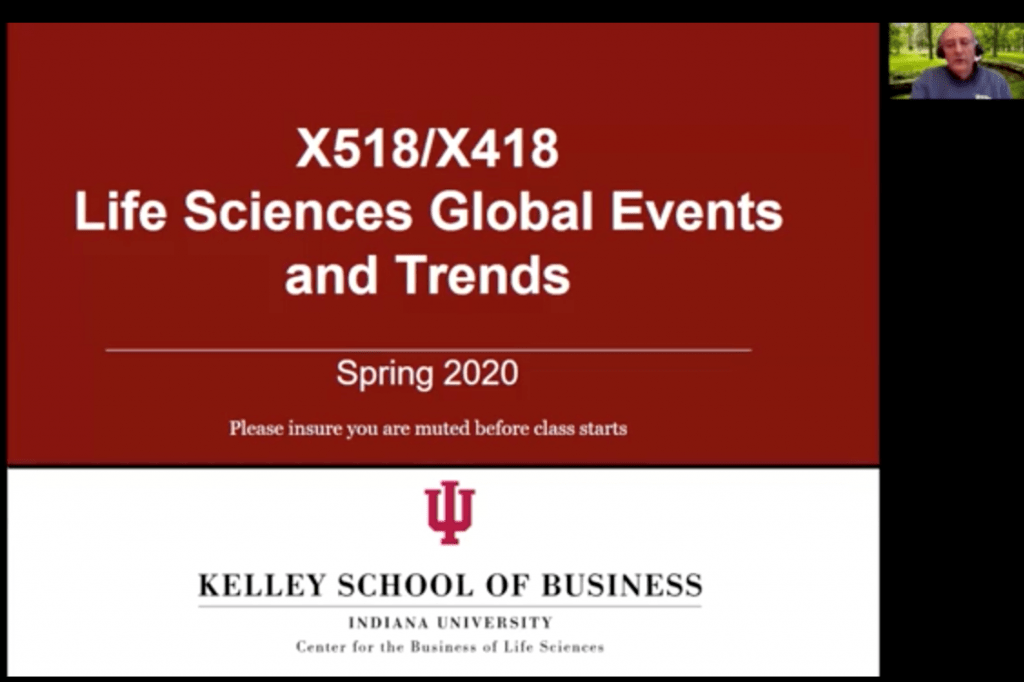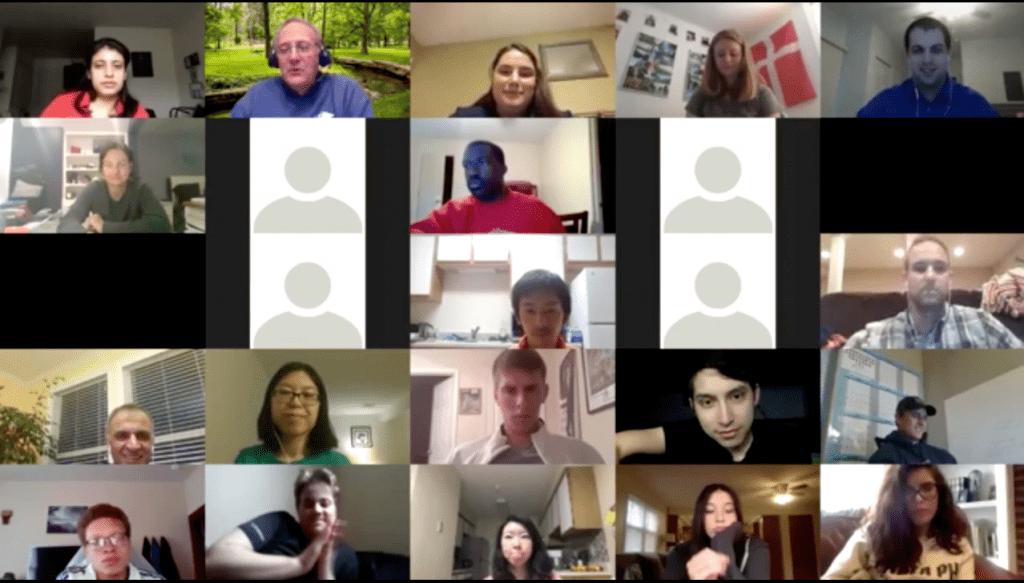By Mitchell McBrairty, MBA Candidate Class of 2021
The courses in the CBLS remind me of a classic joke that pokes fun at each functional area within a business.
Ask each one “What is Pi?” and you’ll get a different answer:
- The Engineer: The circumference of a circle divided by its diameter (well… technically that is correct).
- The Accountant: 3.1415926535, because they always need more precise numbers.
- The Marketer: 2.51, or 20% off of the standard value.
- The Salesman: The best constant that ever existed and will fulfill all your needs.
- The Operations Manager: Are you sure that circles are the most efficient?
- The Strategy Consultant: A delicious baked good. I hope we have some in the cafeteria!

Professor George Telthorst opens the Global Life Sciences Trends & Events course with current news and introduces guest lecturers who are executives in the industry. Photo Credit: Mitchell McBrairty
It’s quite the knee slapper, but the joke illustrates an important point: Each function offers very different areas of expertise, perspectives, and motivations. For a business to operate properly, it must coordinate all of these competing interests. This semester I had the pleasure of taking the Global Events and Trends Impacting the Life Sciences Industry course offered by the Kelley Center for the Business of Life Sciences. This course groups together undergraduates from various majors, PhD students, MS in Healthcare Management and MBA students representing a wide array of disciplines ranging from molecular biology to finance to healthcare policy. This feature of the course allowed for an experience that replicated cross-functional collaboration in a way that prepared us to navigate these team dynamics in our future careers.
Each of the course’s main lectures started with a round-table discussion of the latest industry news led by George Telthorst, the CBLS director. This was followed by lectures and a Q&A session with three guest speakers from the industry who shared current developments in their fields, covering topics including such as cost pressures, government regulation, legal systems, aging demographics, emerging markets, and digital health. This exposed all of us to different companies and functional areas that enhanced our general understanding of the healthcare industry and gave context to our personal interests. The course leveraged the diversity of the students business and technical backgrounds in forming teams to work together on term-long case competition. In this assignment, we were presented with a real business problem affecting a large pharmaceutical corporation. The project centered around an example of the status quo in an industry being disrupted by an innovative new entrant, and how the established leader would react to stay on top. The underlying dilemma of this case was extremely relevant to any industry and forced us to coordinate our cross-functional team to deliver a winning strategy.
Gisela Cairo, a PhD student working in the Soni Lacefield lab that specializes in Genome Cell & Developmental Biology, participated as a team leader for one of these groups. As a student of the sciences, she says “it was very difficult at first to get used to the different environment of a class focused on the business of life sciences, but after connecting with the lecturers and students I felt that it was a valuable experience. I also loved that I got the opportunity to bring in my science expertise by explaining to my classmates how CRISPR/CAS9 (the core technology discussed in the case) works and how it is relevant to the industry landscape. “ This was Gisela’s second CBLS course after taking one in the fall semester, she shared how she was surprised that the move to a virtual setting changed the class dynamic less than she might have expected,“There was less time for those little interactions in between speakers and at the end of class, but the lectures themselves as well as our meetings to work on the group project were very similar.”

Students interact virtually during the question and answer portion of the spring Global Events and Trends in the Life Sciences Industry course. Photo Credit: Mitchell McBrairty
I too was worried about how the effects of the coronavirus would transform the classroom experience. However, during one of the lectures about globalization I began to think about these concerns in a new light. Our workplace environments were already increasing the requirement for effective long-distance communication. This is especially true for many of us that will work with global partners where time changes and cultural differences make things even more difficult. The seemingly endless zoom meetings may eventually be commonplace even after the work from home orders have been lifted, and therefore learning how to effectively communicate to run a remote team is becoming an essential skill. After this realization, I placed more value on the virtual setting and began to view the format as yet another experiential component of the course.
Many of the MBAs in the class are now headed for their summer internships, the senior undergraduates and MS in HM students to a new position at amazing healthcare companies, and the PhD students are preparing to defend their dissertations. Whatever the next chapter is, this course has given all of us a trial run into how to bring our specific expertise to the table and to be a part of a productive team that can deliver results.
ABOUT: The Kelley Global Events and Trends in the Life Sciences Industry is a course offered as a part of the Certificate in the Business of Life Sciences offered by the Kelley Center for the Business of Life sciences. To learn more check out the Student Associates page on the CBLS website.
Leave a Reply